This section allows you to view all posts made by this member. Note that you can only see posts made in areas you currently have access to.
Topics - KermMartian
1
« on: February 25, 2016, 04:38:41 pm »
In the theme of education with Texas Instruments' T^3 2016 conference starting tomorrow, this has been the week for new educational tools at Cemetech. Two days ago, we announced C programming support in SourceCoder 3, which allows you to write C programs for your TI-84 Plus CE in your browser. Now, we're proud to present Learn @ Cemetech, documentation to help you use your calculator and program in TI-BASIC, z80 Assembly, ez80 Assembly, and C. We will be migrating other information like our Calculator Documentation pages to the new Learn @ Cemetech wiki. You can also expect the following information: - With help and permission from z80 Heaven administrator The Cow, we're proud to present a curated, updated version of z80 Heaven's documentation about z80 assembly.
- Cemetechian and ez80 programmer Hactar has given us his blessing to host information from ez80 Heaven as he develops this resource for ez80 assembly programmers.
- With help and permission from TI-BASIC Developer administrator jonbush, we're very proud to offer an updated subset of TI-BASIC Developer's TI-BASIC command reference and tutorials. We'll be continuing to update it with TI-84 Plus CE-specific information, crossreferences to other TI-BASIC documentation, and thus are calling it Cemetech's (Adapted) TI-BASIC Developer Reference. We hope you'll help us expand it as well!
- We anticipate that we'll be able to include some TI-84 Plus CE C programming documentation, with the help and assistance of our knowledgeable members.
We owe a huge debt of gratitude to the administrators around the community who have worked with us to make this new resource possible. Equally or perhaps more importantly, we need you to work with us to bring the community the best possible documentation. If you find any mistakes, anything you think should be added, or even new areas of information that the Learn @ Cemetech wiki should be covering, don't hesitate: jump right in and start editing. If you encounter any difficulties, just post and we'll try to figure out what went wrong. Graphing Calculator and Programming Help Learn @ Cemetech Learn @ Cemetech graphing calculator reference 
2
« on: February 23, 2016, 04:02:11 pm »
It's been over two years since I first posted news entitled " SourceCoder 3 Nears Completion", but today, I'm proud to say that SourceCoder 3 actually is nearing completion. Unless you looked closely at the version number at the bottom-right of SourceCoder 3's main menu, I bet you might not have realized that SourceCoder 3 was technically still in beta, but I'm happy to say that in preparation for T^3 2016 and as various planned features come together, it has reached Release Candidate status. The biggest brand-new feature is in-browser compiling of ez80 C programs for the TI-84 Plus CE, but myriad other tweaks, adjustments, fixes, and updates have been added to SourceCoder 3 in the past two years. If you've hung around Cemetech long enough, you probably know what SourceCoder 3, but if not, it's a universal in-browser IDE for graphing calculator programmers. It can help you write BASIC, Assembly, and C programs for TI-83 Plus and TI-84 Plus graphing calculators, edit and export lists, numbers, matrices, pictures, AppVars, and more, and even edit Casio fx-9860 and Prizm programs and images. With the integrated jsTIfied emulator, you can test programs right in your browser, take screenshots, and never need to use an offline calculator or offline emulators. In fact, SourceCoder and jsTIfied even work on smartphone and tablets (including the iPad), meaning that students in schools that issue Chromebooks or iPads can still use it. I'll save the exhaustive list of features for the inevitable SourceCoder 3.0 announcement; for now, here are the highlights of what has been added to SourceCoder in the past two years: - TI-84 Plus CE C Support: Thanks to help from Cemetech administrators Tari and elfprince13, as well as excellent tools and libraries developed by the inimitable Cemetech moderator MateoConLechuga, you can now write, compile, and export C programs for the TI-84 Plus C right in your browser. With TI-84 Plus CE support planned for jsTIfied, you'll even be able to test C programs in an in-browser TI-84 Plus CE.
- Overhauled Interface: Awkward dropdown menus and huge icon-filled buttons are a thing of the past. SourceCoder 3's editor now shows all of the files in a project as tabs, and contains a sleeker interface above the editor. Layout is now almost purely done in CSS (rather than the older Javascript layout engine), and is designed to flow better on devices with smaller screens.
- Indentation: TI-BASIC and C programs are automatically indented as you type to make it clearer where your loops, conditionals, and functions start and end. In addition, indentation is automatically added to programs that you upload. As with many other features, you can turn indentation on and off from the Settings tab of the main menu, and you can choose how many tabs or spaces to use to indent your code.
- z80 ASM and ez80 ASM Support: Thanks in great part to Tari's emscriptening of SPASM-ng, you can write, assemble, and test z80 and ez80 ASM programs directly in SourceCoder 3. Projects can also contain multiple assembly programs and includes that are assembled together.
- Casio fx-9860 and Prizm Images: SourceCoder 3 can import and export Casio calculator images, which required reverse-engineering and documenting the format.
Have you found SourceCoder 3 useful? Let me know! Have you encountered bugs while using it lately? I definitely need to know that too. Finally, although I'm anticipating adding only one additional planned feature for SourceCoder 3.0, feature requests are always welcome. Launch Tool SourceCoder 3 Online TI-BASIC, ASM, and C Editor and IDE SourceCoder 3 Online TI-BASIC, ASM, and C Editor and IDE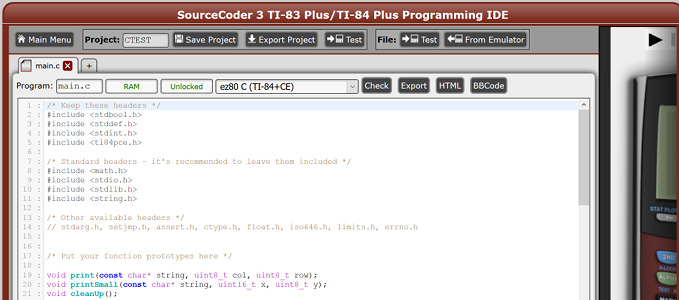 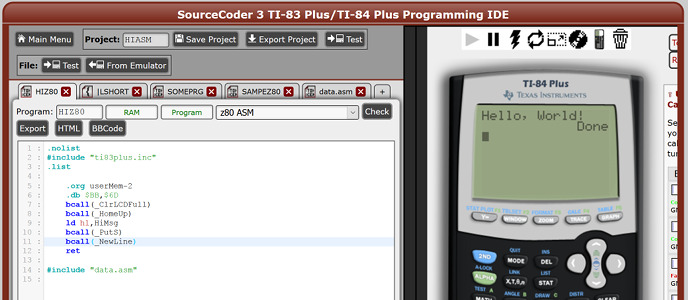
3
« on: January 26, 2016, 04:15:09 pm »
After nearly two years of work, a closed beta, and an open beta, I'm proud to present Graph3DC for the TI-84 Plus C Silver Edition. In the time this project has gestated, the TI-84 Plus C Silver Edition has gone from the leading member of the TI-84 Plus family to a barely-remembered third cousin of the sleek new TI-84 Plus CE, but completionist that I am, I refused to let the work I put into Graph3DC go to waste. Therefore, I present today a 3D graphing App for the TI-84 Plus C Silver Edition, capable of graphing up to five simultaneous equations in the form Z=f(X,Y). It integrates with the TI-OS, like TI's Transformation Graphing and Inequality Graphing Apps, and thus can offer 3D graphing within the TI-OS graphing tools that students and teachers already know how to use (while leaving 2D graphing instantly available to avoid any confusion). As stated in the recent Open Beta 2 news article about Graph3DC, among its most distinguish features are: - Rendering and rotation of 3D graphs on up to a 17x17-point grid at normal resolution, or 27x27-point grid at high resolution.
- Simultaneous graphing of up to 5 3D equations at normal resolution, or 2 3D equations at high resolution.
- Tracing over graphs to examine the (X, Y, Z) coordinates of points.
- User-configurable grid colors, background colors, bounds and axis display, axis labels, and more.
- User-settable window and zoom.
- TI-OS integration with the Y=, Window, Zoom, Trace, and Graph tools.
- Full compatibility with horizontal splitscreen mode.
As I once stated in the Graph3DC Closed Beta 1 news article, and have repeated ever since, one of my primary motivations behind creating (and finishing) Graph3DC was "to show TI that by releasing the keys necessary for us to write free Apps for their TI-84+CE, they'll be only strengthening that platform's appeal to students, teachers, and programmers." I wanted TI to know that the community can not only create powerful, fast games and useful programming tools for students, but can also create educational applications that are genuinely helpful in the classroom. For better or for worse, that appears to no longer be feasible, but I can say with some confidence that if I have the time, I will port Graph3DC to the TI-84 Plus CE as a non-App program runnable using Doors CE 9. In fact, had I chosen to make Graph3DC a non-App program from the beginning, I think the program would have been released months, if not years, earlier. Why? The vast majority of the time I spent creating Graph3DC was not invested in the 3D graphing, computation, and rendering code, but in building hook after hook to integrate with the OS, and more importantly, to work around OS bugs. Examining how TI's own Transform and Inequality Graphing Apps work reveals an intricate set of hooks to make the Y= menu work properly when augmented by an App's extra features and much more. Graph3DC drew heavily on my experience creating Doors CSE for the TI-84 Plus CSE, requiring me to make cursor hooks to make the flashing Plot1 to Plot 3 cursor in the Y= menu work properly, a key hook to skip to a correct Z= equation in the Z= menu when the OS's own features didn't quite work properly, myriad redisplay hooks to work around quirks in the OS's implementation of horizontal split-screen mode, and so many more. Although I'll have to implement my own input routines for a theoretical Graph3DE for the TI-84 Plus CE, I suspect that the development time will be significantly decreased with the burden of interacting with the TI-OS removed. Without further ado, please enjoy Graph3DC at the download link below. If you'd like to explore some fun 3D equations right out of the box, take a look at the included readme PDF, and also refer to the equations and screenshots posted by tireless beta-tester PT_. In fact, I'd like to thank everyone in the community who helped test Graph3DC and who encouraged me to press onwards even when the project felt insurmountable. If you're a teacher, I would especially be interested in hearing from you, but I hope anyone will feel free to share comments, questions, and suggestions for future versions. Claims of an easter egg embedded in the App are completely unfounded. Download Graph3DC 1.0 Graph3DC 1.0 3D grapher for the TI-84 Plus C Silver Edition 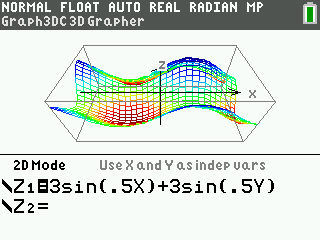 
4
« on: December 15, 2015, 07:07:09 pm »
Last month, we resurrected Cemetech programming contests with Cemetech Contest #14: TI-BASIC Connect 4 AI Challenge. In that short contest, designed by Cemetech members jonbush and earthnite, entrants were tasked with writing an AI to play Connect 4 in pure TI-BASIC. We congratulate JWinslow23 for winning that contest, and are happy to announce a longer, more elaborate contest. Cemetech Contest #15 is entitled Crypto Golfing, and is a multi-part contest. Starting today, and continuing every Tuesday until January 12th, we will release encrypted data with possible hints for a new challenge. Your mission, should you choose to accept it, is to create a program to decode each piece of encrypted data, be it a string, a number, an image, or something else, in as few bytes as possible. The top two overall winners will win a TI-84 Plus C Silver Edition and a TI-Nspire CX (with the first place winner getting first choice). As in previous Cemetech contests, we'll have a number of categories; the sizes of entries from each category will be weighted at the discretion of the judging panel. - TI-83 Plus/TI-84 Plus TI-BASIC, ASM, C, or Axe: Programs in any of these languages for any calculator with "TI-83 Plus" or "TI-84 Plus" in its name will be accepted, including the TI-84 Plus C Silver Edition and TI-84 Plus CE. Hybrid TI-BASIC and z80 ASM programs must use only the libraries available in Doors CS or Doors CSE, to make grading easier.
- TI-Nspire CX and HP Prime: Lua entries for the TI-Nspire CX and CX CAS as well as PPL programs for the HP Prime will be accepted.
- Computers: Java, Javascript, C++, Rust, Haskell, and Python: For those who focus on computer programming these days, computer programming solutions will be accepted in the languages listed. Want to write in another language? Let us know what that language is in the attached Cemetech topic, and we'll consider it.
The usual rules apply: - Contestants may not release any code or binaries before the end of the contest, including asking for programming help publicly or privately. Violators will be disqualified. Projects that have already been released in any form (excluding a contest project topic) already are not eligible for the contest.
- The contest will run until January 19th, 2016, at 11:59:59pm Eastern Time. No late entries will be accepted. Entries to any of the five challenges will be accepted up until this deadline. The earlier you submit each challenge's solution, the higher your score!
- All contestants must maintain a topic in the Contests subforum on Cemetech, including a first post that mentions the programming language(s) you'll be using. You can also post the size of your entries and when you complete them. Do not post algorithmic solutions, code, or hints.
- Submit entries by emailing them, in a zip file, to contest at this domain name. Be sure to provide your Cemetech username in the subject or body of the email so we know who you are! Each Cemetech member can submit a single entry in one or more of the accepted language + platform combinations.
- Judging will be performed by a team picked from among the Cemetech administrators and members; all judges are disqualified from entering the contest. Results will be posted no later than ten days after the end of the contest.
- Algorithmic grading will be performed, based on the size of each entry's source code (or for assembly, assembled binaries) and how early the entry was submitted. Speed will not be graded.
- As with the Contests #12 and #13, we are very proud to offer two brand-new calculators as prizes. The grand prize winner will be awarded one TI-84 Plus C Silver Edition or one TI-Nspire CX, as chosen by the winner. The second-place winner will receive the remaining calculator. Additional Cemetech swag may be added to the prizes at the Cemetech staff's discretion. All participants will earn Cemetech flair in the form of signature bars and respect.
So what are you waiting for? Get coding, solve Challenge 1, push yourself to learn something new in the process, and win some calculators! Challenge 1: GSVHVXIVGNVHHZTVRHLOWDRAZIWMore Information Contest #15 Rules Contest #15 Rules  Both of the two remaining of these six generously-donated calculators will be awarded as prizes. A special thanks to our anonymous donor for making this contest possible! Both of the two remaining of these six generously-donated calculators will be awarded as prizes. A special thanks to our anonymous donor for making this contest possible!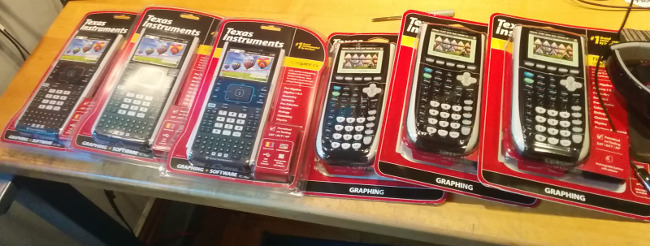
5
« on: December 10, 2015, 02:23:40 pm »
Since the release of TI's thin, light, ez80-powered TI-84 Plus CE graphing calculator, I have received countless YouTube comments, Cemetech PMs and posts, and emails about when Doors CS / Doors CSE would be available for the new calculator. Stumbling blocks including technical limitations related to the new calculator and my own lack of free time had forced me to say that I wasn't sure when or if a version of Doors CS/CSE would be available for the TI-84 Plus CE. For a long time, I hoped that an App key might become available from TI so that there might be a TI-84 Plus CE App version of Doors CS/CSE. It appears that that's not forthcoming, so in the meantime, I've been working on a port of Doors CS/CSE as a program, to be called Doors CE. Like the much-celebrated Cesium from Cemetech Expert MateoConLechuga, the new Doors CE is visible in the [PRGM] menu, and can be started by running a prgmA that Doors CE creates when you install it. Since the beginning of October, I have been documenting my progress on putting together a Doors CE port for the TI-84 Plus CE. The following features have been completed, delta a little debugging: - Launcher: Doors CE creates a special launcher when it is installed and archives its bulk as an AppVar to leave RAM for user programs. The launcher also switches between Doors CE and assembly programs when the user executes a program.
- Desktop: Doors CE can display BASIC and Assembly programs on its desktop, list an arbitrary number of programs, and scroll. Locked, archived, and hidden programs are correctly annotated as such. Folders can be created, and files can be moved between folders. Programs can be created, renamed, duplicated, deleted, and even edited. The clock works.
- Doors CE and Options Menus: The Doors CE menu ("start" menu) works correctly, and each of its sub-menus functions. The Options menu works, and most of the options in Options do what they're supposed to.
- Executing nostub BASIC programs: BASIC programs can be executed from the Doors CE desktop from RAM or Archive.
- Executing nostub ASM programs: ASM programs can be executed from the Doors CE desktop from RAM or Archive. Writeback is correctly performed.
There are a few features that still need to be added, and they're big ones: - HomeRun: The HomeRun feature that lets programs be executed from the homescreen, regardless of whether they're BASIC or ASM, Archived or in RAM, or require libraries is incomplete (but nearly done). BASIC programs currently work; ASM programs do not.
- xLIBCE: The venerable Patrick "tr1p1ea" Prendergast is working hard to port xLIBC to the TI-84 Plus CE for inclusion in Doors CE. Since he has a busy job and a young family, I appreciate his willingness to work on xLIBCE in his minuscule free time.
- Celtic 2 CE: I will be porting the Celtic 2 CSE libraries from Doors CSE. With the permission of authors like MateoConLechuga, I may add additional functions, including ToString.
- ASM/C libraries: MateoConLechuga has also strongly hinted that he is completing tools that will make it easy to use ASM and C libraries in programs without explicit shell support. Doors CE will be leveraging this time- and effort-saving breakthrough from Mateo.
If you still need to get psyched about Doors CE, enjoy the video below. Although I don't have a concrete release date for Doors CE, I do plan to get it out in the early part of 2016. I'd be happy to field suggestions and answer questions in the attached topic or in the Doors CE 9 Development thread, where development updates will continue to be posted.
6
« on: April 20, 2015, 02:31:16 pm »
Adding assembly support to SourceCoder 3 has long been on my to-do list, and a happy confluence of factors has allowed me to begin to make this a reality. First, and arguably most importantly, I just finished a very important deadline at work, so I have a little more free time to actually work on personal projects. Secondly, inimitable Cemetech administrator Tari built the SPASM assembler using Emscripten (and put together the necessary wrappers and online demo), allowing SPASM to be run in a browser. Finally, calc84maniac and alberthro took the time to add ez80 support to SPASM, creating a new tool called SPASM-ng. With these three components, I've put together support for ASM programming in SourceCoder, and I'm already thrilled at how fast it lets me iterate my build/test cycle. SourceCoder 3 now lets you write, assemble, and test z80 and ez80 assembly programs directly in your browser. First, SourceCoder's ability to handle multiple files, syntax highlighting, and saved projects means you can put together assembly projects with several source files, edit them comfortably in your browser, and save them to access on any computer, even your phone. Second, SPASM-ng compiled with emscripten means that you can assemble your programs in your browser, on Windows, Mac OS, Linux, Android, iOS, or anything else that supports modern Javascript. Finally, you can export .8xp files directly from SourceCoder, or if you want to test your programs, simply send them directly to the jsTIfied calculator emulator built into SourceCoder. Because you can write z80 or ez80 assembly programs, this tool will not only be useful for existing assembly projects, but for many new projects that explore the powerful new TI-84 Plus CE. If you're an assembly programmer, I'd love to hear your feedback from trying out SourceCoder 3's new z80 and ez80 assembly support.  SourceCoder 3 TI-BASIC and Assembly Editor and IDE SourceCoder 3 TI-BASIC and Assembly Editor and IDE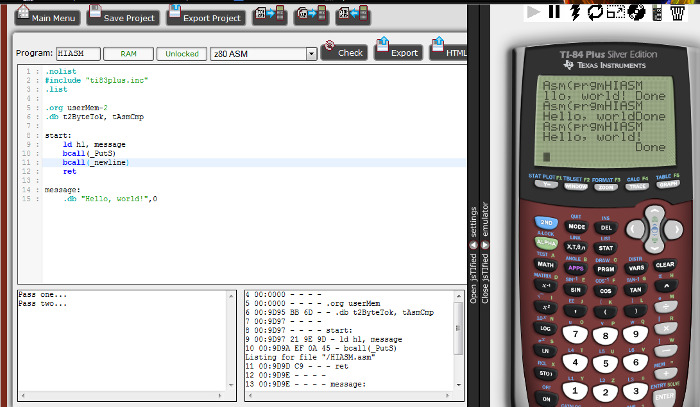 Cross-posted from z80 and ez80 ASM Support Added to SourceCoder 3 on Cemetech Cross-posted from z80 and ez80 ASM Support Added to SourceCoder 3 on Cemetech
7
« on: November 26, 2014, 12:24:58 pm »
 Another fun-filled Cemetech contest starts today! This contest's theme has three requirements:- You must make a game.
- It must involve both of the following thematic elements: It will be up to you, the contestant, to determine how best to integrate these two thematic elements within the creative fabric of your game.
- You must target one of the following hardware/language platform combinations:
- Any calculators in the TI-83 Plus through TI-84 Plus C Silver Edition line, using BASIC, Hybrid BASIC, ASM, or Axe.
- TI-Nspire, using Lua only
- HP Prime, using HPPL
- Casio Prizm, using C/C++ or BASIC
This contest comes with just under a month of development time: entries will be due by 11:59:59 PM EST, on December 20th. The usual rules apply:- Contestants may not release any code or binaries before the end of the contest, including asking for programming help publicly or privately. Violators will be disqualified. Projects that have already been released in any form (excluding a contest project topic) already are not eligible for the contest.
- The contest will run until December 20th, 2014, at 11:59:59pm Eastern Time. No late entries will be accepted.
- All contestants must maintain a topic in the Contests subforum on Cemetech, including a first post that mentions the name, programming language, and topic of the entry.
- Judging will be performed by the Cemetech administrators (all of whom are disqualified from entering). Results will be posted no later than ten days after the end of the contest.
- A grading rubric is attached below. Entries will be graded primarily on their entertainment value, polish, and consistency with the given theme ("Space and Cats").
- Although the focus is on gaming, and we intend this primarily as a fun educational experience for the contestants, we also will be impressed if you manage to sneak some teaching moments into your game.
As with the previous contest, we are very proud to offer two brand-new calculators as prizes. The grand prize winner will be awarded one TI-84 Plus C Silver Edition or one TI-Nspire CX, as chosen by the winner. The second-place winner will receive the remaining calculator. Additional Cemetech swag may be added to the prizes at the Cemetech staff's discretion. All participants will earn Cemetech flair in the form of signature bars and respect. As you can see below, our anonymous donor has generously provided six calculators as contest prizes, so you can rest assured that this winter season will at least one additional contest where you can win these prizes. So what are you waiting for? Getting coding, make a fun game, challenge yourself to learn something new in the process, and win some calculators! More Information Contest #13 Rubric Contest #13 Rubric Contest #13 Rules Two of the remaining four of these six generously-donated calculators will be awarded as prizes, with the remainder awarded for another upcoming contest. A special thanks to our anonymous donor for making this contest possible! Contest #13 Rules Two of the remaining four of these six generously-donated calculators will be awarded as prizes, with the remainder awarded for another upcoming contest. A special thanks to our anonymous donor for making this contest possible!
8
« on: September 23, 2014, 06:46:08 pm »
The act of engaging in activities (such as programming or other media) in a spirit of playfulness and exploration is termed hacking. [...] Hacking entails some form of excellence, for example exploring the limits of what is possible, thereby doing something exciting and meaningful. September 20 and 21, 2014, Cemetech made its third trek to World Maker Faire in New York City to show off Learn Hacking and Coding with Graphing Calculators. As in 2012 and 2013, the focus of our booth this year was to spread the word about graphing calculators as a tool for learning programming and electronics, or "hacking". We showed off the different things you could make graphing calculators do, from networking, to connecting to the internet, to playing music, to running educational programs and games. We also showcased resources for learning to use calculators for math and science as well as for programming. Our displays (click any photo for the full size), from left: the east side of the tent, with networking, internet-connected calculators, and books; calculators networked together; internet-connected calculators; interactive calculators with math and science programs and games; calculators playing music with speakers and a floppy drive.      This year, we had our largest crew of participating Cemetech staff and members yet. I ( Christopher Mitchell) was joined once again by Cemetech administrator Thomas Dickerson, Cemetech member Alec Szigeti, and Cemetech and Omnimaga administrator Tim Keller. Cemetech member and Omnimaga owner Nathaniel van Diepen trekked down from Canada to join us in showing off our work as well, bringing along his wooden TI-82 created by Caleb Hansberry as well. We gave out over eight hundred bookmarks with Cemetech's URL and an invitation to join us for calculator, computer, and DIY hardware hacking and programming. We chatted with thousands of people of all ages, some new to calculator hacking, some old veterans with great stories of the early hobbyist community. We found that the students, parents, engineers, and teachers visiting our booth were even more tech-savvy than in previous years, and many were receptive to the arguments for graphing calculators as a platform for teaching programming. Among the interactions that particularly stand out in our minds: - A teacher who works with at-risk teens in the Washington, DC area who has no budget for computers, but has graphing calculators and wants her students to explore programming and robotics.
- A science teacher in the NYC area who has CBL devices and told us that she wants to show her students programming, including interfacing with the CBL.
- A professional programmer who didn't get started coding with graphing calculators, but who "honed his ability to translate an idea into a program" with his calculator.
- A professional programmer who writes Objective C and Swift now, but started programming with his trusty TI-83 Plus.
- Students who have been writing TI-BASIC programs on their own in school, and who were excited to learn that there is an online community of enthusiasts to learn from and work with.
- Younger students excited by the prospect of what they will be able to do once they get graphing calculators for school.
- A familiar friendly face from TI stopped by, as well as Cemetech member and community legend Patrick Davidson, and members ACagliano, pyrot3chnic, docbill, and balrog. Docbill told us about his classroom lessons on using TI calculators as coprocessors for microcontrollers, and inspired us to try to build our own lesson plan for teachers around similar projects.
We were thrilled to win two Editor's Choice awards from Maker Faire for our efforts, joining two Educator's Choice awards and one Editor's Choice award that we earned in the preceding two years. We look forward to continuing to spread our message about teaching programming with graphing calculators and to working directly with teachers, parents, and enthusiastic students alike. Special thanks to Tim Keller for spending time, money, and effort to make us very professional-looking displays, and to the whole Cemetech team who helped out this weekend. Thank you also to Peter Balyta and Gayle Mujica for their personal enthusiasm on Twitter and LinkedIn about our participation in the Faire. You can check out our full album of photos from Maker Faire 2014 and an informal video showing our displays. 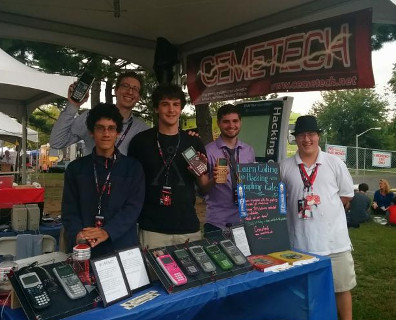 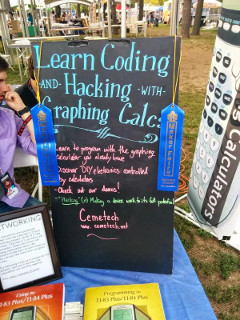
9
« on: July 02, 2014, 11:41:43 am »
Cemetech has a long history of hosting programming contests for the community. Most recently, we held a Lightning Contest (our eleventh contest), and last summer, we hosted Contest #10: Physics. We have had generous sponsors who have provided prizes for these past contests, and now that we have all prizes and a topic for a new contest, we are ready to announce Contest #12: Educational Shenanigans. Since we unoficially announced the topic over a week ago, we are thrilled to see that some Cemetech members have already started their entries, but now it's your turn to brainstorm a contest entry. Cemetech Contest #12 challenges you to create an educational program for the TI-83 Plus/TI-84 Plus. While we will allow games in this contest, our primary challenge to you is to create a program that teaches something, be it geography, geometry, history, literature, foreign language, engineering, physics, music, or any other subject. The rules are simple: - Write a program or game that teaches a subject. Make it as educational or game-like as you want, as long as it teaches specific skills. This is key: programs that don't qualify as educational also won't qualify for this contest.
- Programs must be in TI-BASIC, Axe, or ASM. All 83+, 83+SE, 84+, and 84+SE programs will be tested on a TI-84 Plus Silver Edition running under Doors CS 7.2, so any libraries offered by Doors CS 7.2 may be used. All 84+CSE programs will be tested on a TI-84 Plus C Silver Edition running under Doors CSE 8.1, so any libraries offered by Doors CSE 8.1 may be used.
- Contestants may not release any code or binaries before the end of the contest, including asking for programming help publicly or privately. Violators will be disqualified. Projects that have already been released in any form (excluding a contest project topic) already are not eligible for the contest.
- The contest will run for 8 weeks, ending August 27th, 2014, at 11:59:59pm Eastern Time. No late entries will be accepted.
- All contestants must maintain a topic in the Contests subforum on Cemetech, including a first post that mentions the name, programming language, and topic of the entry.
- Four weeks from today, a special prize to be announced will be awarded to the entry that shows the most progress and promise, based on the posted screenshots and updates in the Contest subforum. Progress will be judged by the updates over time. The same entry can theoretically win this progress prize as well as one of the main prizes.
- Judging will be performed by the Cemetech administrators (all of whom are disqualified from entering). Results will be posted no later than ten days after the end of the contest.
- A grading rubric is attached below. Entries will be graded primarily on their educational value, polish, and appeal to students. Although the focus is on education rather than gaming, educational games are allowed as long as they teach concrete skills. We will be particularly impressed by educational programs reaching beyond math and science.
I'm sure you want to hear more about the prizes. We are very proud to offer two brand-new calculators. The grand prize winner will be awarded one TI-84 Plus C Silver Edition or one TI-Nspire CX, as chosen by the winner. The second-place winner will receive the remaining calculator, and the third-place winner will win a refurbished calculator, likely a spiffy TI-83+SE. Additional Cemetech swag may be added to the prizes at the Cemetech staff's discretion. All participants will earn Cemetech flair in the form of signature bars and respect. As you can see below, our anonymous donor has generously provided six calculators as contest prizes, so you can rest assured that this fall will bring two additional contests where you can win these prizes. So what are you waiting for? Getting coding, inspire students to use calculator for more than math, and win some calculators! More Information Contest #12 Rubric Contest #12 Rubric Contest #12 Rules Two of these six generously-donated calculators will be awarded as prizes, with the remainder awarded for one or two contests in Fall 2014. A special thanks to our anonymous donor for making this contest possible! Contest #12 Rules Two of these six generously-donated calculators will be awarded as prizes, with the remainder awarded for one or two contests in Fall 2014. A special thanks to our anonymous donor for making this contest possible!
10
« on: May 11, 2014, 12:31:52 pm »
Texas Instruments' Silverlink is a product to connect calculators without USB ports (namely everything except the TI-84 Plus series and the TI-89 Titanium) to computers' USB ports to transfer files, screenshots, and operating systems. The Silverlink was first introduced about fifteen years ago, and the early models are already starting to show their age. A number of Silverlinks, including my own, have failed over time, and we anticipate that the rest will gradually lose their firmwares (with no way of repairing them) in the next decade or two. To fill this gap, ideas for a community-coded Silverlink clone have been kicking around for several years. Tim " geekboy1011" Keller has taken the initiative in creating Silverlink clone software for the Arduino Leonardo (ATmega32U4) microcontroller development board. Tim started from my Arduino to TI calculator linking routines, which he ported from Arduino "C" to bare-AVR C. He was able to deduce the file transfer protocols from a combination of USB sniffing, the venerable TI Link Protocol & File Format Guide, and occasional sanity-checking against the TILP repository. Tim is using the LUFA library for AVRs to handle USB; the flexibility of the library lets his Silverlink clone appear to be an original Silverlink to the host computer, and thus requires no new drivers. Since it appears to be a regular Silverlink to computer-side software, Tim's clone works with both TI-Connect and TiLP, the two popular software options for linking TI calculators and computers. We look forward to Tim's continuing work on this project, and hope this and other projects will help retired calculators to remain useable and useful for many years to come. You can find more information about this project as well as an ongoing project log in the topic linked below. More Information SilverLink clone information and progress log: Cemetech, Omnimaga.  Cemetech Cemetech source article: A Silverlink Clone to Rescue Pre-USB Calculators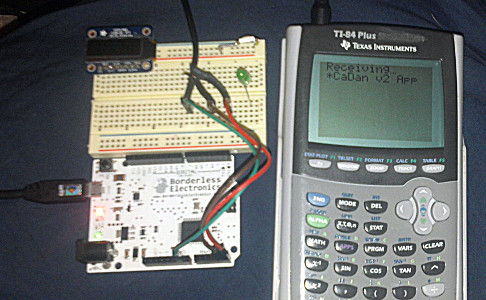
11
« on: February 24, 2014, 11:24:44 am »
jsTIfied, an online emulator for the TI-73, TI-81, TI-82, TI-83, TI-83+/SE, TI-84+/SE, and TI-84+CSE, has been steadily growing in features and popularity since the first LCD-less version booted a TI-83+ OS on December 4, 2011. One of the most popular additions has been TI-84 Plus C Silver Edition support, which made jsTIfied one of the if not the only free TI-84+CSE emulator around. In an effort to keep jsTIfied as one of the most useful graphing calculator emulators around, I have now finished a round of fixes and upgrades that make it more featureful, faster, and lighter-weight. It can run at 100% emulation speed on more platforms and browsers, and offers more tools to assembly programmers and TI-84+CSE users. Without further ado, some of the highlights of the new features: :: Better TI-84+CSE LCD Support: One of the biggest overhauls is a rewrite of the TI-84+CSE LCD (ILI9335) emulation. The addition of an intermediate GRAM buffer made it possible to support partial images, interlacing, vertical offset, inversion, and much more. The upshot is that every TI-BASIC and ASM program currently available for the TI-84+CSE, including xLIBC programs that use half-resolution mode, can be run on jsTIfied. :: Ability to drag-n-drop to RAM or ROM: As with other popular offline calculator emulators, you can drag-n-drop calculator files directly to RAM or Archive. :: Debugger Upgrades: Tons of new debugger features are now available, from multiple breakpoints and memory watchpoints to an improved disassembler and read-write memory viewer. :: Animated GIF improvements: Although the intricacies of generating animated GIFs from Javascript at a decent speed mean that jsTIfied occasionally makes poor choices in palettizing TI-84+CSE animated screenshots, it is now better able to avoid egregious errors. :: (Much) faster emulation: With the help of relative newcomer UnknownLoner, a few structural changes to jsTIfied's z80 core have made it execute 2x-3x faster on some hardware. The upshot of this is that most users will now be able to emulate their calculators at 100% speed or even faster with jsTIfied. In addition, a "full speed" button (the lightning bolt symbol) has been added for when you want jsTIfied to execute as fast as possible. In addition, scads of smaller tweaks and fixes have been implemented, including some necessary to support jsTIfied integration into SourceCoder 3. If you're a user, teacher, or programmer, I strongly encourage you to give jsTIfied a try and see if it's right for you. As always, bug reports and feature requests are welcomed and encouraged. Use jsTIfied jsTIfied online graphing calculator emulatorBelow: 100% emulation speed (left) and full emulation speed on a Core i5 desktop (right) jsTIfied online graphing calculator emulatorBelow: 100% emulation speed (left) and full emulation speed on a Core i5 desktop (right)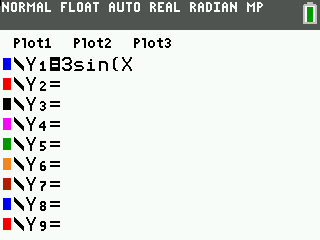 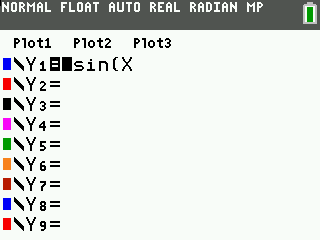
12
« on: February 13, 2014, 03:27:25 am »
I think I was one of the last people on the Internet to hear about the stupendously popular smartphone game "Flappy Bird", since I shy away from casual gaming. However, when even a monochrome calculator version appeared in our archive queue, it became clear that the game has completely saturated the collective Internet consciousness. It was with some reluctance that I realized sooner or later it would have to reach the color-screen TI-84 Plus C Silver Edition, so it is with rather mixed feelings that I present Flappy Bird Color, an homage to the original game. What made the original such an overnight success? The concept is not a new one; tunnel/helicopter/jetpack games have been a staple of casual gaming for decades, as evidenced by the folder full of such games for the monochrome TI-83 Plus/TI-84 Plus. The gameplay is not outstanding, and even the art more than heavily evokes Mario, complete with replicas of warp pipes. Nevertheless, through a combination of addicting frustration and word-of-mouth, it has achieved great notoriety. You pilot a bird through a narrow tunnel of pipe-like obstacles, telling the bird when to fly upwards and when to fall with gravity. Although the concept is simple, playing the game is table-poundingly annoying. While I tried to make this game equally frustrating to pay tribute to its inspiration, please don't smash or damage your calculator, as there are plenty of less frustrating things you could be using your calculator for. Flappy Bird Color requires Doors CSE 8.0 or higher. Please see the Readme for more information and disclaimers, and I apologize in advance for the time that you'll waste playing this game. Download Flappy Bird Color Flappy Bird Color for the TI-84 Plus C Silver Edition   
13
« on: February 04, 2014, 03:49:39 pm »
Graphing calculators are nothing less than powerful pocket computers, capable of doing many of the same things as smartphones, desktops, and laptops. Given that they have reasonably fast processors, a display, memory, and ports to interface with the outside world, I set out to making graphing calculators capable of determining their location using standard GPS hardware. I started with the TI-84 Plus / Silver Edition series of graphing calculators, which have a 15MHz processor, a 96x64-pixel monochrome screen, rudimentary timers (as well as one 32KHz crystal timer), and perhaps most importantly, two ports to interface with the outside world. One is a USB OTG port, a mini-USB port capable of acting as either a host or device, and therefore capable of producing 5V for peripherals. The other is a "serial" I/O port with two bidirectional TTL-level data lines. For my project, I chose to use the USB port for power, and the I/O port to communicate with a TTL serial GPS module. I created both the hardware and software necessary to make the project a reality, then suffered through two weeks of trying to get a GPS fix amid the metal canyons of a major US city. Along the way, the two major technical challenges I faced were building a serial library and powering the module from the calculator. Once I succeeded in building functioning hardware and software, and eventually got a video of the GPS device operating normally, I documented the project in the writeup, video, and pictures linked below. Enjoy, and I challenge you to try building this project as well! More Information GPS for graphing calculators documentation GPS for graphing calculators documentation Video of TI-84+SE receiving GPS data Video of TI-84+SE receiving GPS data GPS driver for TI-84+/SE GPS driver for TI-84+/SE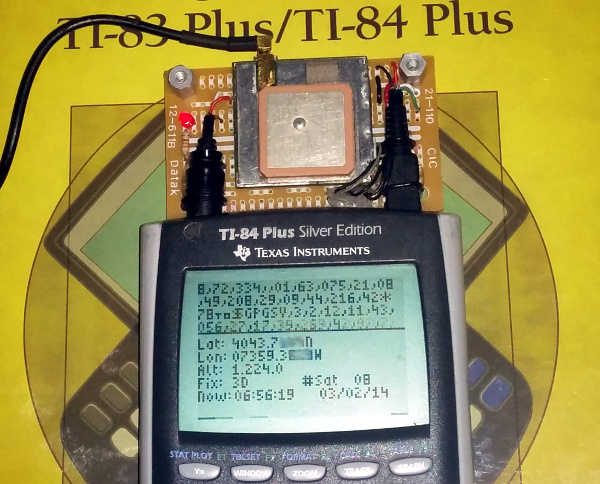 Cross-posted from this Cemetech topic Cross-posted from this Cemetech topic
14
« on: January 20, 2014, 03:01:41 am »
For over a month, as first reported this past Christmas, the TI-BASIC editor and IDE SourceCoder 3 has been back under development. An upgrade of the aging SourceCoder 2 project, it incorporates all of the features from the older tool and adds many new features, wrapped up into a spiffy web application. Spurred by feature requests from the community and newly-feasible technical aspects, I have implemented features like command completion, argument hinting, a sprite editor, and much more. SourceCoder 3 can edit programs, lists, matrices, appvars, strings, pictures, images, and more. In fact, here's a fairly complete list of the currently functioning features in SourceCoder 3: :: Editing TI-BASIC programs for the TI-83 Plus/TI-84 Plus and the TI-84 Plus C Silver Edition, Axe programs, and Grammer programs. :: Syntax highlighting for TI-BASIC, Axe, and Grammer programs. :: Command completion for TI-BASIC commands and some Axe commands by typing the beginning of a command and pressing Ctrl-Space. :: Argument hinting and command explanations for TI-BASIC and some Axe commands. For example, typing "seq(" displays the arguments to the seq( function, followed by a brief explanation of what the seq( command does. Thanks to Deep Thought and TI respectively for transcribing and creating these descriptions.:: Sprite editor for monochrome, 3- and 4-level grayscale, and 16-color TI-BASIC and Axe sprites. You can edit existing sprites in programs or create new sprites. :: Loading, editing, and saving lists and matrices, including importing from and exporting to CSV files that can be used by many numerical programs including Excel and Matlab. :: Importing and exporting Picture and Image formats for the monochrome and color calculators, allowing you to save calculator images as computer images and convert computer images to be viewable on your calculator. :: Embedded jsTIfied calculator emulator can emulate the TI-73, TI-81, TI-82, TI-83, TI-83 Plus/SE, TI-84 Plus/SE, TI-84 Plus C Silver Edition, TI-82 Stats.fr, TI-76.fr, and TI-83 Plus.fr. You can send files or projects directly from SourceCoder to jsTIfied and from jsTIfied to SourceCoder, allowing you to test out your programs without installing anything on your computer. :: Export strings, AppVars, and programs as syntax-colored HTML or BBCode, allowing programs to be posted on personal or school websites or shared on forums. :: Projects that include one or more programs, appvars, strings, lists, matrices, and real numbers can be stored in your Cemetech account and opened from SourceCoder on any computer. Projects can be imported from calculator files (.8xp, .8xg, and so on) and exported back to such files. So what's left before SourceCoder 3 is complete? Of SourceCoder 2's features, counting loop commands in TI-BASIC and indenting code are missing, and will eventually be added to SourceCoder 3. In addition, pictures cannot currently be saved as part of SourceCoder 3 projects. However, given the stability and completeness of SourceCoder 3 in its current form, I will be moving on to my next project and forcing all existing SourceCoder 2 users to switch to SourceCoder 3. Please enjoy SourceCoder 3, tell your colleagues about its many powerful features, and as always, don't hesitate to post bug reports and feature requests in the attached topic. Access TI-BASIC Editor SourceCoder 3 TI-BASIC Editor SourceCoder 3 TI-BASIC Editor: View, edit and export TI-83 Plus/TI-84 Plus/TI-84 Plus C Silver Edition list, matrix, program, AppVar, picture, string, number, image, and group files Selected SourceCoder 3 features, clockwise from top-left: command completion, multi-file projects, sprite editor, TI-BASIC editing with command arguments and explanations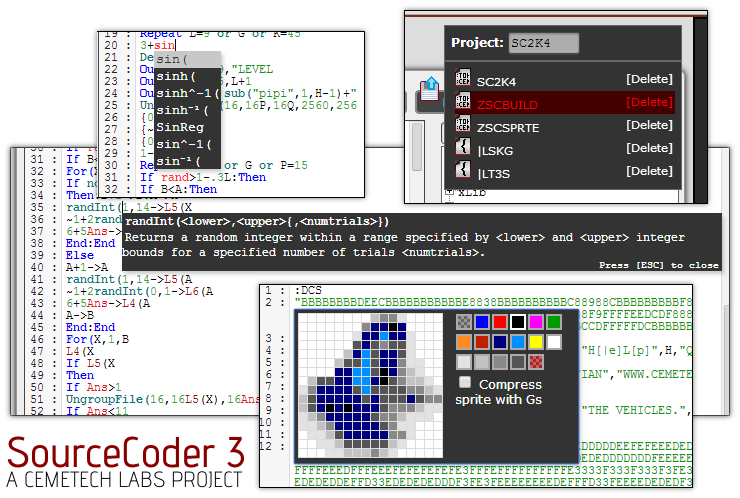 News cross-posted from SourceCoder 3 Nears Completion News cross-posted from SourceCoder 3 Nears Completion
15
« on: December 31, 2013, 04:28:28 pm »
In August 2012, we started discussing the idea of a Cemetech Minecraft server. We had a powerful dedicated server for the task, and more and more Cemetechians were playing the game. For over a year, we hosted a Survival server (publicized along with our Unreal Tournament 2004 server in an October 2012 news article), but with the release of Minecraft 1.7.x, we decided to do something new. For about three weeks, a dozen hard-working Cemetech members have been creating a new map and server for Cemetech's Minecraft server. They built an expansive, beautiful spawn with modern buildings and rustic paths, a powerful world-wide railroad system, and helped me configure a variety of plugins for the most fun, safe experience possible. I'm happy to announce that the Cemetech Minecraft Server 2.0 is now open. Cemetech's Minecraft server is PvP, using Towny, and includes an economy (or in Minecraft terms, Cemetech Minecraft Server [PVP/Towny/iConomy]. I feel strongly that a competitive PvP environment will make for fun gameplay. I've long played on other PvP servers, and I always play a defensive game, building a well-fortified town with traps, walls, and extensive farms. With the maturity and intelligence of Cemetech's userbase, I anticipate beautiful towns with excellent defenses, fun raids, and complex political intrigue. We use Towny, so if you just want to build, you can get the money to make a town, then create protected builds inside the town. Towns cost the equivalent of 2 gold ingots per real-world day, so if you hate mining, you can even create an overworld Zombie Pigman farm and collect gold from that. We urge you to hop onto mc.cemetech.net, bring all your friends, and start building. If you have suggestions about ways we could make the server even more fun, please post them here. I want to especially thank (in alphabetical order) Abrum, AHelper, CharlesSprinkle, Chronomex, ComicIDIOT, CVSoft, Leafiness, LuxenD, Merthsoft, Pizzaboy, Rivereye, Shkaboinka, and Turiqwalrus for their help creating this new map and server. See you in Minecraft! More Information: Server Address: mc.cemetech.net Cemetech Minecraft Server Dynmap Cemetech Minecraft Server Dynmap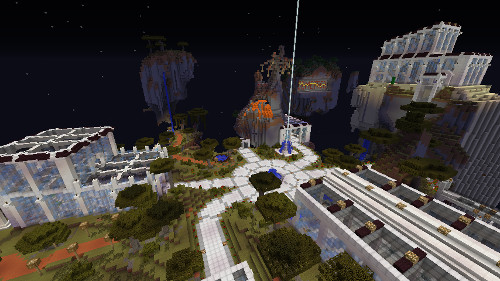
|
 Learn @ Cemetech graphing calculator reference
Learn @ Cemetech graphing calculator reference


























